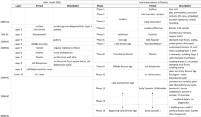The Middle Bronze Age occupation
During the first half of the 2nd Millennium BCE the occupation concentrated on the main mound of Gird-i Shamlu and probably also the top of the shallow mound just east of the main mound. Whether the transition from the 3rd to 2nd millennium BCE was continuous or whether the settlement had been abandoned in between is one of the central questions that the project is trying to answer by investigating levels belonging to both periods.
According to Kadhim al-Janabi, who directed short salvage excavations at the site in 1961, his excavations reached Isin Larsa and Old Babylonian levels. They were followed by meager architectural remains of layers that were defined by the occurrence of a handmade incised pottery. As comparable objects at that time had been discovered neither in Mesopotamia nor Iran, Janabi named it "Shamlu pottery". The table below correlates al-Janabis results with the stratigraphy established through the excavation of two small step trenches by the Shahrizor Survey team excavated in 2012 and 2013.
Our new excavations in Sector 1 on the main mound have reached the youngest remains of layers with Shamlu pottery occurrence below disturbed Late Bronze Age remains. One room of a mud-brick building was filled with collapse debris. Above these remains, we discovered an ancient surface covered with Shamlu pottery sherds and charred grain. A 14C sample collected from this surface dates this phase to the end of the 17th century BCE and the beginning of the 16th century BCE.
Examples of plain and incised Shamlu ware sherds.

